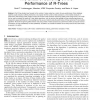Free Online Productivity Tools
i2Speak
i2Symbol
i2OCR
iTex2Img
iWeb2Print
iWeb2Shot
i2Type
iPdf2Split
iPdf2Merge
i2Bopomofo
i2Arabic
i2Style
i2Image
i2PDF
iLatex2Rtf
Sci2ools
ICDE
1998
IEEE
1998
IEEE
The Effect of Buffering on the Performance of R-Trees
?Past R-tree studies have focused on the number of nodes visited as a metric of query performance. Since database systems usually include a buffering mechanism, we propose that the number of disk accesses is a more realistic measure of performance. We develop a buffer model to analyze the number of disk accesses required for spatial queries using R-trees. The model can be used to evaluate the quality of R-tree update operations, such as various node splitting and tree restructuring policies, as measured by query performance on the resulting tree. We use our model to study the performance of three well-known R-tree loading algorithms. We show that ignoring buffer behavior and using number of nodes accessed as a performance metric can lead to incorrect conclusions, not only quantitatively, but also qualitatively. In addition, we consider the problem of how many levels of the R-tree should be pinned in the buffer.
| Added | 01 Nov 2009 |
| Updated | 01 Nov 2009 |
| Type | Conference |
| Year | 1998 |
| Where | ICDE |
| Authors | Scott T. Leutenegger, Mario A. Lopez |
Comments (0)

